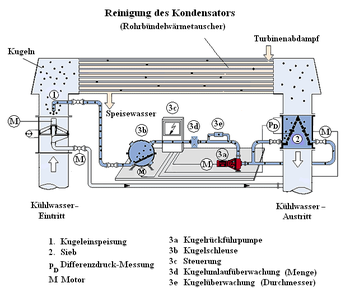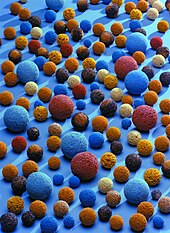Taprogge
| Taprogge GmbH | |
|---|---|
| legal form | Company with limited liability |
| founding | 1953 |
| Seat | Weather (Ruhr) |
| Number of employees | 350 |
| Branch | Plant construction |
| Website | www.taprogge.de |
The Taprogge GmbH is a medium-sized company based in Wetter (Ruhr) in North Rhine-Westphalia . The company, founded on March 1, 1953 by the businessman Ludwig Taprogge (born September 18, 1920 - February 3, 2008) in Düsseldorf-Angermund , has been manufacturing cleaning systems and later filters for water-cooled tube bundle heat exchangers and condensers since then. The family company with around 350 employees is regarded as the market leader in this technological area and has branches and agencies in many countries around the world.
Corporate development
The brother of the company's founder, Josef Taprogge, developed a continuously operating cleaning system as an engineer for power plant technology in what was then the steam power plant in Essen-Kupferdreh . He installed a prototype in the cooling water pipe of the power plant. This kept the condenser free of contamination while the steam turbine was in operation .
The process , which was further developed and marketed by the company, was widely used in power plants during the period of the economic miracle due to its efficiency. The increase in efficiency within the power plants equipped with the systems has since been around two to four percent, so that this investment pays for itself within a few months. The degree of familiarity of the cleaning process became so great among experts that the term Taprogge process has become established in the specialist literature to this day . The company therefore expanded rapidly. In 1957 a branch was established in the USA, followed by a branch in Great Britain in 1963 and a branch in Japan in 1967. On December 15, 1997, the Chinese production site in Shanghai was established as the previous conclusion .
Cleaning systems
The process invented and patented by Josef Taprogge uses sponge rubber balls that are fed into the flow of cooling water (1) before entering the condenser . At the outlet of the condenser there is a sieve (2) in the pipe that is the same size as the cooling water pipe, which retains the balls from the water flow and leads them into a pipe with a nominal diameter of DN 80. From there they are pumped back to the starting point by a centrifugal pump (3a) with an output of four kW and a pipe with DN 80. In order to be able to introduce the balls into this circuit for the first time, a pressure vessel with a detachable cover is located behind the pump . Inside this pressure vessel , called lock (3b), there is also a sieve and a flap . When the flap is open, the balls can pass; when the flap is closed, they remain in the lock and can be added or exchanged. The process works continuously, the pipes remain free of stubborn dirt such as mud , algae , bacteria and scale . The operation of the system is monitored via sight glasses and electronic measuring devices such as differential pressure measurement. The surfaces of the sieves are rotatably mounted on shafts and can be swiveled if necessary in order to remove dirt from the water flow. The balls are caught in the lock during this process. This time-consuming process is automated (3c), gear motors (M) operate the necessary drives . The nominal size of the screens has been able to keep pace with the growth spurts of power plant technology to date and 150 to DN 4900. For extends from DN each tube diameter of the heat exchanger must sponge rubber balls are used with appropriate diameter, in the design of the ball diameter, the possible existence of is streets tubes with take into account the reduced inner diameter.
Purification systems for seawater desalination are manufactured as a special process. Here is seawater heated and there is brine . Brine is very corrosive and particularly resistant materials must be used for such systems. Because of the large pipe diameter in the evaporators , the cleaning balls have a diameter of up to 45 mm.
Filter systems
In the 1970s, the development of backwash filters was carried out as a further product line in order to protect the heat exchangers and condensers from coarse contamination such as stones, pieces of wood, fibers, plastic films and shells. In the filters marketed by the company today, the foreign bodies initially settle on the filter surface. As soon as a certain differential pressure has formed between the filter inlet and outlet due to the contamination, the filter is rinsed. An electrically driven rotor runs over the filter surface, which is connected to a pipe with a connection to the outside. In this pipeline there is a valve that is opened during the flushing process. Through this arrangement, the accumulated dirt is sucked off and transported away through the pipeline, which in turn leads behind the condenser to be protected into the main cooling water line or to a dirt collecting tank. This technology was also used worldwide in power plants and industrial plants. The filters are manufactured in nominal sizes from DN 150 to DN 3200, depending on the amount of water to be filtered. The filter surface is made of stainless steel with punched holes. In the case of difficult contamination cases , filter surfaces made of plastic and gratings can be used. As a further design, the company produces fine filters with gap widths from 50 µm to 1000 µm.
Extraction filter for pre-cleaning
Since the end of the 1990s, the company has offered another filter system that holds back dirt as it enters the cooling water system. The basis for the conception of this filter system was the consideration of protecting the entire system equipped with it, as well as its sometimes long pipelines, from contamination when the cooling water is withdrawn. The system called "TAPIS®" (Taprogge Air Powered Intake System) is installed at the inlet of the cooling water pipe in the open water as a polyhedral housing with flat filter surfaces and is regularly cleaned by blowing it out of a compressed air pipe. The filter, made of stainless steel, does not have any moving parts under water , in contrast to the flotsam rakes that are also used and can handle large amounts of water. The filter surfaces are made of coated plastic and are provided with drilled holes.
Market positioning
Taprogge GmbH is seen as the market leader in its market segment . In addition to improving the efficiency of the power plant process to reduce the stands at the company's customers emission of carbon dioxide in fossil -fired steam power plants in the foreground. The cleaning and filter systems are installed in around 90% of all steam power plants worldwide, and there is a similarly high level of market penetration in industry. The company has been based in Wengern since 1984 , and there are other branches with production facilities. a. in Japan , China and the USA . There are agencies and branches in over 60 countries. The products are largely planned , constructed and manufactured in-house on 10,000 m² of hall space.
Since it was founded, the company has been owned by the Taprogge family as a family business .
Individual evidence
- ↑ Business Strategy Competitive Positioning (PDF; 4.5 MB) ( Memento from January 13, 2012 in the Internet Archive ) Lecture by Prof. Dr. Bernd Venohr , Berlin University of Applied Sciences, p. 44
- ↑ Product and Service Innovation in Small and Medium-Sized Enterprises (PDF; 915 kB) ( Memento from December 2, 2008 in the Internet Archive ) Prepared by Smeal College of Business The Pennsylvania State University, p. 19 f.
literature
- Reduction of the formation of deposits and corrosion in power plants: manual; Fuel selection, monitoring, constructive measures, cleaning systems / Essen, Ruhr: PUBLICO Publ., 2004, p. 256 ff., Springer, VDI Verlag, ISBN 3-934736-13-0
- Heat Exchanger Cleaning Systems: Manual; Method for reducing and removing deposits and contamination / Essen, Ruhr: PUBLICO Publ., 2001, pp. 186 ff., ISBN 3-934736-02-5
Web links
- Website of Taprogge GmbH
- First page of the patent “Process for self-cleaning tubes in tube heat exchangers and the device for carrying it out” by Josef Taprogge
Coordinates: 51 ° 23 ′ 37 ″ N , 7 ° 21 ′ 15 ″ E



